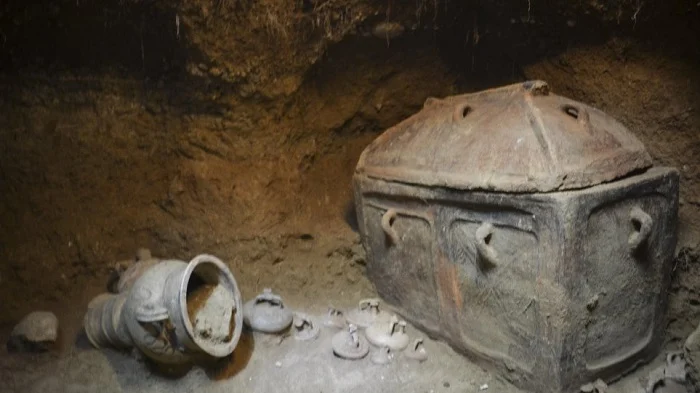In the summer of 2018, a surprising event unfolded on the island of Crete, in the small village of Rousses. A farmer, going about his daily routine, stumbled upon a piece of ancient history that had remained hidden for thousands of years. This accidental discovery not only captured the attention of archaeologists but also added significant depth to our understanding of the Minoan civilization.
The Discovery: A Stroke of Chance
The story began when the farmer attempted to park his vehicle under the shade of an olive tree on his property. As the weight of the car pressed on the ground, the earth suddenly gave way, creating a hole approximately 1.2 meters deep. Initially surprised, the farmer inspected the cavity more closely and realized he had uncovered something extraordinary: an ancient tomb buried beneath his land.
When archaeologists arrived, they confirmed the tomb to be of Minoan origin, dating back around 3,400 years to the Late Bronze Age (circa 1400 BCE). This period marked the zenith of the Minoan civilization, a sophisticated society known for its palaces, art, and trade networks.

What Was Found: Artifacts of a Bygone Era
Inside the tomb lay a larnax, a small, closed coffin or ash box often used in Minoan funerary practices. The larnax was intricately decorated, showcasing motifs characteristic of Minoan art, such as spirals, marine life, and geometric patterns. Beside it were several ceramic vessels, believed to have been offerings intended for the deceased in the afterlife.
The pristine condition of the tomb was particularly remarkable. Unlike many ancient sites that are often looted or damaged over the centuries, this tomb remained untouched. This allowed researchers to analyze the artifacts in their original context, offering invaluable insights into Minoan burial customs and spiritual beliefs.
Significance of the Find
The discovery sheds light on several aspects of Minoan culture:
- Burial Practices
The presence of a larnax and accompanying grave goods suggests the deceased was likely a person of status. The Minoans believed in an afterlife, and such offerings were meant to accompany the soul on its journey. - Artistic Expression
The designs on the larnax and the ceramic vessels provide a window into the artistic traditions of the Minoans. The motifs reflect their connection to nature and their sophisticated aesthetic sensibilities. - Material Culture
The artifacts reveal details about the materials and techniques used by Minoan artisans. For instance, the ceramics demonstrate advanced pottery skills, while the larnax reflects the symbolic and ritualistic significance of burial items.

Broader Implications for Archaeology
This discovery also highlights the untapped potential of archaeological exploration in Crete. Many ancient sites remain buried beneath modern landscapes, waiting to be uncovered. Accidental finds like this one emphasize the importance of protecting and studying these hidden treasures.
Moreover, the untouched nature of the tomb provides a rare opportunity for archaeologists to study an unaltered Minoan burial site. Such discoveries contribute to the broader narrative of the Minoan civilization and its influence on the Mediterranean world.
Conclusion
The accidental unearthing of a 3,400-year-old tomb in Rousses serves as a poignant reminder of the deep layers of history that lie beneath our feet. Beyond its archaeological significance, this discovery enriches our understanding of the Minoans, a civilization that continues to captivate historians and the public alike.
As researchers continue to analyze the artifacts and their context, we can hope for new revelations about the spiritual, artistic, and social lives of the Minoans. This find underscores not only the richness of Crete’s history but also the serendipity that sometimes drives our exploration of the past.
